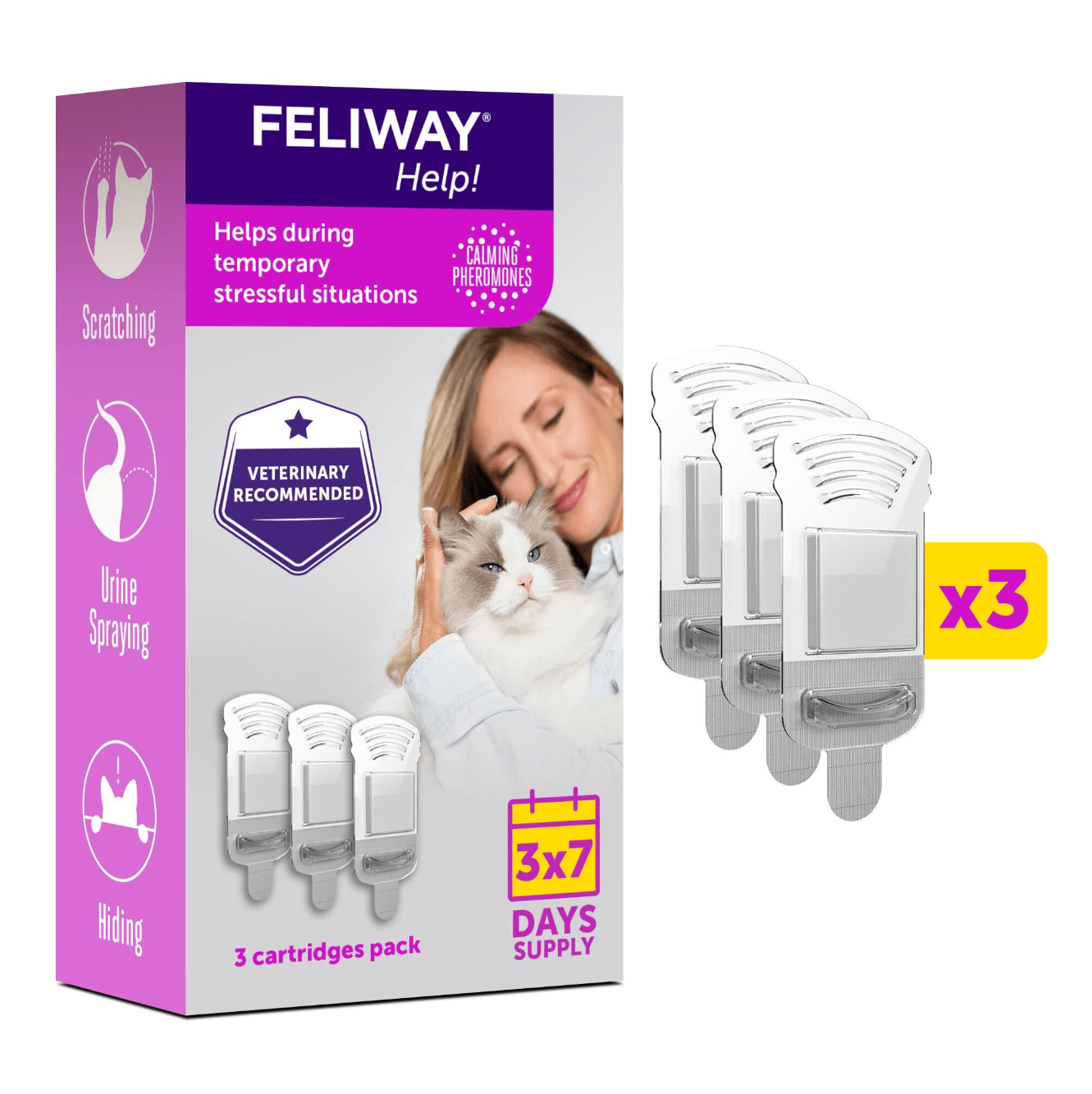
Cat Behaviour After a Fight: Signs to Watch for and How to Help
Domestic cats are independent by nature, but that doesn’t mean they don’t like human or feline companionship; cats can live harmoniously together and, indeed, become the best of buddies – as long as they are in the same social group. If you see your cats grooming or rubbing against each other and sleeping with their bodies touching, you can be confident that they are in the same social group and they have bonded.
But no matter how friendly your cats are, they will still want their own space and separate resources (food bowls, litter boxes, safe spots etc.) if you are to maintain kitty harmony!
Regardless of your cats relationship together, the right support can help your cats get along perfectly, including FELIWAY Optimum, which helps cats feel more serene and comfortable in various stressful situations.
Cat Behaviour After a Fight: Signs to Watch for and How to Help
It can be difficult to tell the difference between playing and fighting! They often look the same, but there are subtle differences that you need to be able to spot, to know whether you should allow your cats to carry on or if you should intervene. It’s all in the body language!
Characteristics of cats playing
If your cats are having a fun time playing:
- Their bodies will be relaxed with their ears pointing forward
- Their claws will be retracted
- Biting is soft and gentle with no injury to the skin
- They take it in turn to chase, stalk or pounce on each other
- They might take a little break to get into a different position and start all over again. It’s normal for playing cats to return to normal when it’s just fun. But if they start to hide or avoid each other, that’s a sign that it might be conflict.
Characteristics of cats fighting
However, if they are in conflict:
- Their bodies will be tense with flat ears and a low swishing tail
- They will have a sideways stance
- They will puff their bodies to make themselves look bigger
- Their claws will be out when they swipe
- You may hear them growling or hissing
Signs to watch for
Cats generally don’t like physical conflict, and have lots of other subtle signs they’ll try first, to show that they are not completely comfortable in each other's company.
Watch for:
Staring and blocking
Before fighting, cats will keep their distance, stare at one another, and may circle, trying to control the situation. They may also try to block the other cat from accessing their resources.
Swiping and hissing
Escalating a little, cats in conflict might then have one paw off the ground, extended, with claws out ready to defend themselves or to tap the other cat. Listen to the sounds your cats make, as aggressive cats will communicate their feelings with lots of hissing and growling.
Overgrooming and spraying
If you find that your cat is overgrooming or urine spraying around the home, this can be a sign of tension and stress, which may be caused by kitty conflict.
Note that if your cats are in actively in the middle of a scrap, your should not try to intervene physically, or you may get injured. It is best to try and distract the cats instead.
How to help your cats live happily together
Try to understand the reason for the conflict. If your cats have previously got on well together, there could be a variety of reasons for the sudden change in behaviour.
Perhaps they have been away from home for a while; did they stray from home for a few nights? Have they been hospitalised for a while? When they return home, their communal scent will be different; a cat’s sense of smell is incredibly important to them as they use it to gather information about their surroundings, and if this has changed while they were ‘away’ it could unsettle them.
If your cats have been good friends previously but are now fighting, a vet check is a good idea to check for any underlying problems that may be impacting how they interact with each other. A qualified behaviourist can also help with a plan to help cats that are showing signs of conflict – in the meantime, keep them separated.
If you are introducing a kitten, or an older cat, to your resident cat, you should not expect them to bond immediately. All cats are individuals, and will adapt at their own pace. As such, some cats will quickly become best buddies, others might choose to tolerate each other - and others may never get on, even with support.
However, there are 6 steps that you can take to help them get along.
-
Prepare for the introduction in good time before your cats meet each other:
- Swap scents between cats before the new kitten/cat arrives.
- Let them see each other from a distance first and supervise their first face-to-face encounter.
- Stay calm and never shout at them if there are any signs of hissing or conflict. This will only scare them and they will be reluctant to try again. Just remove both cats from the situation and try again another time when they are both calm.
- Have plenty of treats to hand and reward them staying calm
- Remember that introductions can take time, and depends on how well each cat copes. Only progress with the steps when both cats are comfortable - it’s ok to stop and go back a step when you need to! - Use FELIWAY Optimum to provide enhanced serenity to your cats for 30 days. The reassuring messages can help restore harmony to your cats and your home.
- Make sure there are enough resources (food bowls, litter trays, beds etc.) – one for each cat and one to spare so that each cat can choose to use a resource independently.
- Make sure the resources are in quiet, accessible areas, distributed around the house so that each cat can access them separately.
- Plenty of climbing places are essential, so that they choose where they want to climb and hide if necessary. Cats love hiding in cardboard boxes and jumping onto shelves or tops of cupboards, but they may be put off using these spaces if, for example, the other cat’s bed is in the way. Make sure that they have easy access to all areas.
- Interact with your cats individually so that there is no conflict for your attention. You will have plenty of love to go round!




































